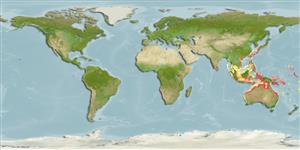分類 / Names
共通名の | 類義語 | Catalog of Fishes(部類, 種) | ITIS | CoL | WoRMS | Cloffa
>
Carangaria/misc (Various families in series Carangaria) >
Leptobramidae (Beachsalmon)
Etymology: Leptobrama: Greek, leptos = thin + old French breme, bresme, a fresh water fish; 1460 (Ref. 45335).
Eponymy: Baron Dr Sir Ferdinand Jacob Heinrich von Müller (1825–1896) was a German-born Australian botanist, geographer, explorer, physician, and naturalist. [...] (Ref. 128868), visit book page.
More on author: Steindachner.
Environment: milieu / climate zone / depth range / distribution range
生態学
海; 新鮮な水; 汽水性の. Tropical
Indo-West Pacific: northern Australia.
サイズ / 重さ / 年齢
Maturity: Lm ? range ? - ? cm
Max length : 37.5 cm SL オス/雌雄の選別がない; (Ref. 30691)
簡単な記述
検索表 | 形態学 | 形態計測学
脊つい: 24. This species is distinguished by the following set of characters: head length 21.7-22.7 % SL, snout length 19.9-24.5 % HL, upper jaw length 53.0-61.3 % HL, snout length 35.6-43.4% of upper jaw length; total gill rakers 13-18; scale rows below lateral line 13-14; vomerine tooth patch is rhomboid; tip of pectoral fin is almost same level as tip of appressed pelvic fin; lateral line gradually curved anteriorly. Colouration: a prominent black spot distally on anterior dorsal fin, with its size almost same as eye diameter or larger (Ref. 129587).
This species is apparently living inshore and migrating into brackish water as the specimens used in this study were collected from the lower reaches of rivers, estuaries or inner part of bays (Ref. 129587).
Life cycle and mating behavior
成熟 | 繁殖 | 放精 | 卵 | 生産力 | 幼生
Kimura, S., T. Peristiwady and R. Fricke, 2016. Taxonomic review of the genus Leptobrama Steindachner 1878 (Perciformes: Leptobramidae), with the resurrection of Leptobrama pectoralis (Ramsay and Ogilby 1887). Ichthyol. Res. 63:435-444. (Ref. 129587)
IUCNのレッドリストの状況は (Ref. 130435: Version 2024-1)
Human uses
用具
特記事項
XMLをダウンロードして下さい
インターネットの情報源
Estimates based on models
Preferred temperature (Ref.
123201): 24.1 - 28.9, mean 27.7 °C (based on 544 cells).
Phylogenetic diversity index (Ref.
82804): PD
50 = 1.5000 [Uniqueness, from 0.5 = low to 2.0 = high].
Bayesian length-weight: a=0.01122 (0.00514 - 0.02450), b=3.04 (2.87 - 3.21), in cm total length, based on all LWR estimates for this body shape (Ref.
93245).
栄養段階 (Ref.
69278): 4.5 ±0.8 se; based on diet studies.
Fishing Vulnerability (Ref.
59153): Moderate vulnerability (36 of 100).
